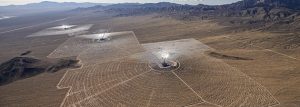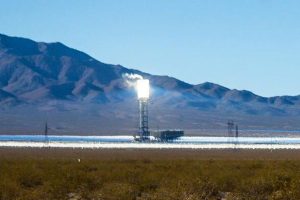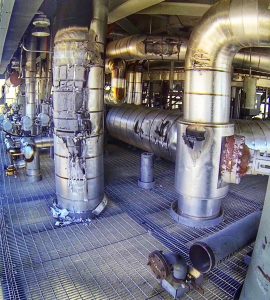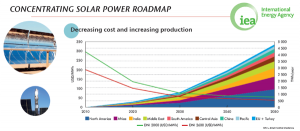to design concentrating solar power plants to generate electricity. However black clouds began to build in the clear blue sky soon…
THE FIRE
A futuristic vision rises out of the Mojave desert in California. This is Ivanpah, one of the world’s largest solar plants. The facility is a glittering sea of mirrors, concentrating sunlight into three glowing towers. The plant’s peak capacity is 390 MW, it operates in the 20-40% range of the rated capacity.

On May 25 2016 fire broke out on Unit 3 tower.

Because of a mirror misalignment concentrated sunlight hit the wrong part of the tower and cables caught fire. The flames could be seen near the ninth floor of the tower, but they had died out by the time firefighters arrived.
It took three weeks for the plant to be back online.

THE ENVIRONMENTAL ISSUES
According to federal U.S. biologists about 6,000 birds die from collisions or immolation annually while chasing flying insects around the facility’s three 40-story towers.
According to the LA Times wisps of white smoke against the blue sky can be clearly seen from I-15 west of Las Vegas, as signs of cruel death of incinerated birds.
There are small steps taken to reduce the number of victims, plant workers have replaced flood lights with LED, which attracts fewer insects and birds that eat them.
Each tower was fitted with machines that emit a nonlethal avian respiratory irritant derived from grape juice concentrate, a method typically used to keep birds from congregating on agricultural fields and commercial centers.
Anti-perching spikes were installed to the towers’ frames, along with devices that broadcast digital recordings of loud, high-pitched shrieking noises that frighten away birds.
Despite the efforts the quantity of animals killed by the facility does not decrease significantly.
THE BUSINESS
Not diminishing the seriousness of the negative environmental impact of the facility one of the main issues is now to come.
A Department of Energy loan guarantee enabled the construction of the $2.2-billion project that supporters touted as a showcase of world-class technology and environmentally friendly development.
Some experts stated however on the very day of the opening of the plant in 2014 that the technology at Ivanpah was outdated and complicated to maintain.
Ivanpah’s biggest problem is the hard economics. When the plant was just a proposal in 2007, the cost of electricity made using Ivanpah’s concentrated solar power was roughly the same as that from photovoltaic solar panels.
Since then, the cost of electricity from photovoltaic solar panels has plummeted to 6 cents per kilowatt-hour (compared to 15 to 20 cents for concentrated solar power) as materials have gotten cheaper.
In the case of a concentrating solar power plant (which is only a large steel and glass project) the cost didn’t decrease.
Photovoltaic solar systems also have the advantage of scaling up or down easily. But for concentrated solar power plants, you need a huge area of empty land. Ivanpah occupies an area of 3,500 acres.
The economics of moving mirrors doesn’t help one iota, parts make Ivanpah more challenging to maintain than static solar panels.
Theoretically, concentrated solar power’s advantage is its ability to smooth out energy production. Solar panels produce energy when the sun is shining, and they’re basically roof decorations when they’re not. At Ivanpah, the water in the towers take time to get to electricity-producing temperatures in the morning, but the towers can continue to produce electricity into the early evening—when electricity consumption is coming off its peak. Plants elsewhere, like Crescent Dunes Solar Energy Project in Nevada, have mirrors that concentrate energy into tanks of molten salt instead of water, which can store the energy much longer.
Because of the hard economics of CSP photovoltaic power is winning out in the US for now.
No one is looking forward to building more concentrated solar power plants there.
THE QUESTION
The final approval for the project Ivanpah was granted in 2010.
I am just wondering what forecast about the would-be cost of solar panels had the decision makers taken into consideration?
Hadn’t they seen what would happen on that market?
The interesting thing is that if you visit the IEA now, you will find that they still see a potential for CSPs even now. Strange.

THE ADVICE
I think the main points in this CSP story are that
- you should be extremely careful about prognoses and
- you should extend the area of potential substitute goods for your product or services and
- you have to continuously monitor the changes on the market of the substitute goods.

Leave a Reply